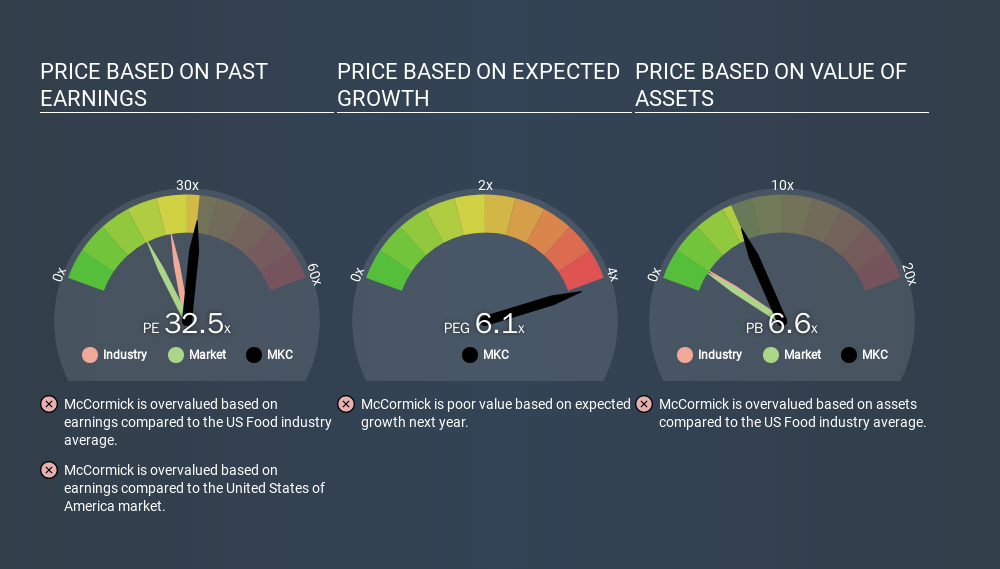- United States
- /
- Food
- /
- NYSE:MKC
Is McCormick & Company, Incorporated's (NYSE:MKC) High P/E Ratio A Problem For Investors?

Today, we'll introduce the concept of the P/E ratio for those who are learning about investing. We'll look at McCormick & Company, Incorporated's (NYSE:MKC) P/E ratio and reflect on what it tells us about the company's share price. McCormick has a P/E ratio of 32.49, based on the last twelve months. In other words, at today's prices, investors are paying $32.49 for every $1 in prior year profit.
See our latest analysis for McCormick
How Do I Calculate McCormick's Price To Earnings Ratio?
The formula for P/E is:
Price to Earnings Ratio = Price per Share ÷ Earnings per Share (EPS)
Or for McCormick:
P/E of 32.49 = USD172.67 ÷ USD5.31 (Based on the trailing twelve months to August 2019.)
Is A High P/E Ratio Good?
The higher the P/E ratio, the higher the price tag of a business, relative to its trailing earnings. All else being equal, it's better to pay a low price -- but as Warren Buffett said, 'It's far better to buy a wonderful company at a fair price than a fair company at a wonderful price'.
How Does McCormick's P/E Ratio Compare To Its Peers?
The P/E ratio indicates whether the market has higher or lower expectations of a company. As you can see below, McCormick has a higher P/E than the average company (25.6) in the food industry.

Its relatively high P/E ratio indicates that McCormick shareholders think it will perform better than other companies in its industry classification. Shareholders are clearly optimistic, but the future is always uncertain. So further research is always essential. I often monitor director buying and selling.
How Growth Rates Impact P/E Ratios
Generally speaking the rate of earnings growth has a profound impact on a company's P/E multiple. When earnings grow, the 'E' increases, over time. That means even if the current P/E is high, it will reduce over time if the share price stays flat. Then, a lower P/E should attract more buyers, pushing the share price up.
McCormick saw earnings per share decrease by 22% last year. But EPS is up 11% over the last 5 years.
Don't Forget: The P/E Does Not Account For Debt or Bank Deposits
It's important to note that the P/E ratio considers the market capitalization, not the enterprise value. That means it doesn't take debt or cash into account. In theory, a company can lower its future P/E ratio by using cash or debt to invest in growth.
Such spending might be good or bad, overall, but the key point here is that you need to look at debt to understand the P/E ratio in context.
McCormick's Balance Sheet
Net debt totals 20% of McCormick's market cap. This could bring some additional risk, and reduce the number of investment options for management; worth remembering if you compare its P/E to businesses without debt.
The Verdict On McCormick's P/E Ratio
McCormick has a P/E of 32.5. That's higher than the average in its market, which is 18.6. With some debt but no EPS growth last year, the market has high expectations of future profits.
Investors should be looking to buy stocks that the market is wrong about. If the reality for a company is better than it expects, you can make money by buying and holding for the long term. So this free visualization of the analyst consensus on future earnings could help you make the right decision about whether to buy, sell, or hold.
You might be able to find a better buy than McCormick. If you want a selection of possible winners, check out this free list of interesting companies that trade on a P/E below 20 (but have proven they can grow earnings).
If you spot an error that warrants correction, please contact the editor at editorial-team@simplywallst.com. This article by Simply Wall St is general in nature. It does not constitute a recommendation to buy or sell any stock, and does not take account of your objectives, or your financial situation. Simply Wall St has no position in the stocks mentioned.
We aim to bring you long-term focused research analysis driven by fundamental data. Note that our analysis may not factor in the latest price-sensitive company announcements or qualitative material. Thank you for reading.
About NYSE:MKC
McCormick
Manufactures, markets, and distributes spices, seasoning mixes, condiments, and other flavorful products to the food industry.
Established dividend payer with proven track record.
Similar Companies
Market Insights
Community Narratives



